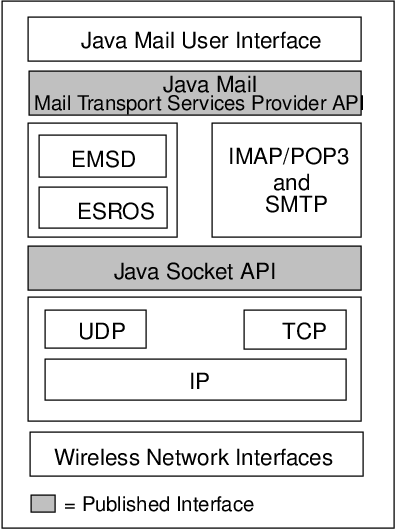LEAP in JAVA
LEAP in JAVA
Mohsen Banan
http://mohsen.banan.1.byname.net/ContactMe
First Published: February 4, 2003
Last Updated: April 26, 2004
Copyright ©2004 Mohsen Banan
copies of this manual provided the copyright notice and
this permission notice are preserved on all copies.
A Component of The LEAP Manifesto
This article is one of a series of articles describing various aspects of the Mobile Messaging industry and the Lightweight &
Efficient Application Protocols (LEAP) protocols. For the complete collection of articles see The LEAP Manifesto [7], available
at
http://www.LeapForum.org/LEAP/Manifesto/roadMap/index.html. The LEAP Manifesto is also available at the Free
Protocols Foundation website at
http://www.FreeProtocols.org/LEAP/Manifesto/roadMap/index.html.
Contents
2 LEAP in Java Resource Center
3 JAVA-WhiteBerry Software Architecture and Components
4 JAVA Mail User Interfaces
4.1 Mail4me
4.2 EMSD-Mail4me
4.3 Configuring Web Server for J2ME JAD & JAR Files Download
4.4 Installation of Mail4ME to Java Phone
4.5 Configuring Mail4ME for ByName Service
5 JAVA Mail API
6 JAVA EMSD
7 JAVA ESRO
8 Invitation to Participate
List of Figures
1 Introduction
This is one of a series of articles that describes the implementation and integration issues involved in incorporating the LEAP protocols into particular hand-held environments. For cell phones in particular, the JAVA implementation of LEAP is the primary approach and the Mobile Messaging application is our first focus.
Like PDAs [2], [6], [5], the starting point for incorporation of LEAP in cell phones consists of the Mobile Messaging application, and is based on the Efficient Mail Submission and Delivery (EMSD) protocol [1]. EMSD is the e-mail component of the LEAP family of protocols [3].
A complete description of how EMSD provides everything necessary to enable end-users to benefit from true end-to-end open mobile messaging based on patent-free protocols and open source and free software is provided in the article Operation Whiteberry [4]. The present article is part of the more general Operation WhiteBerry model. Before reading this article, the reader is strongly encouraged to read Operation Whiteberry so that he/she has a clear understanding of the general implementation framework.
It is our goal to make LEAP widespread on all PDAs and mobile phones. However, the incorporation of LEAP into each platform follows a particular approach and strategy. Each of the articles in this series outlines our strategy for a specific platform.
- Windows CE:
- see ‘”EMSD on WinCE”,[2].
The existing open-source implementation is available at http://www.mailmeanywhere.org.
- PalmOs:
- see ”LEAP on Palm”,[6].
- LinuxPDAs:
- see the article LEAP on Linux PDAs [5] for more details.
This paper in turn focuses on Java implementations of LEAP for mobile phones. The initial primary focus being on support of Operation WhiteBerry.
2 LEAP in Java Resource Center
Latest implementations of LEAP in Java including full sources, binary and related documentation is available at: http://www.mailmeanywhere.org/leapInJava.
In addition to references made in this paper, most up-to-date realted software is available at “LEAP in Java Resource Center”.
3 JAVA-WhiteBerry Software Architecture and Components
Java EMSD implmentation is integrated seamlessly into Java environment using the JavaMail API standard.
See http://java.sun.com/products/javamail for details.
JavaMail architecture supports the concept of a ”Mail Transport Service Provider” which works as an abstraction layer and handles sending/receiving of messages.
JavaMail API can either be used directly or via the factory interfaces of the Java Mail API. The mail user interface can either use the Java EMSD Store and Transport classes directly, or access them via JavaMail API.
In JavaMail API, the Java EMSD is modeled as a Provider along side IMAP, POP, SMTP providers. Java EMSD Provider integrates seamlessly with the Session factory. Unlike the IMAP, POP, SMTP protocols, the EMSD implements both the Store and Transport classes. The configuration file for Java EMSD services in Java Mail API is available in the distribution package.
Our goal in this article is to accommodate incorporation of EMSD as a Mail Transport Service provider in JavaMail model both through defined APIs and also as custom integrated software.
Incorporation of EMSD into the JavaMail model can be rapidly accomplished as an add-on or replacement for SMTP/POP/IMAP. Figure 1 shows the components involved as well as the layering of services in this model.
As illustrated in Figure 1, upper and lower interfaces used by the EMSD user agent correspond to fully published JAVA APIs defined in JAVA development environment (SDK). It is also visible that the EMSD Mail Service Transport Provider is a peer to the SMTP/POP/IMAP Mail Service Transport Provider. The published APIs enable any third party to develop a Mail Service Transport Provider for JavaMail.
Major components of JAVA-WhiteBerry from top to bottom are:
- JAVA Mail User Interface.
- JavaMail API
- JAVA EMSD.
- JAVA ESRO.
- JAVA UDP Interface
each of these are described below.
4 JAVA Mail User Interfaces
Our goal in this article is to accommodate incorporation of EMSD as a Mail Transport Service provider in JAVA both through defined APIs and also as custom integrated software.
The following JAVA mail user interfaces have been identified.
- Mail4me.
Others are likely to be added as they become available.
4.1 Mail4me
Mail4me is a light-weight open source implementation of the SMTP, POP3, and IMAP in J2ME. For more information on the Mail4me please see: http://mail4me.enhydra.org
4.2 EMSD-Mail4me
For integration with Java EMSD the Mail4me Midlet is extended to incorporate the EMSD along side the existing protocols. The user has choice of either using the EMSD, SMTP, POP3, or IMAP.
By default the EMSD is configured to use ByName, ByNumber services. During the first run, the user is prompted with its account information. The information is saved in persistent store, the user has ability to modify the setting at any time.
The access page to sources, binary and documentation for EMSD-Mail4me software is available at: MailMeAnywhere
4.3 Configuring Web Server for J2ME JAD & JAR Files Download
If you try to downlaod a file containing JAR and JAD file to your phone and it only delivered as a text file, this indicates that the web server needs to be configured.
In Apache web server, add the following two lines the the httpd.conf file:
AddType application/java-archive .jar
Restart the web server.
4.4 Installation of Mail4ME to Java Phone
This installation has been tested with Motorola V300 phone. Here are the steps:
- Download the application directly to your Java enabled device by typing the following URL address:
http://www.mailmeanywhere.org/sw.free/repub/mail4me/enhydra/mail4me/src/current/Mail4ME.jad
- From your device, click “Download”. Wait for the .jar file to be downloaded.
- When prompted to run the application, say yes
4.5 Configuring Mail4ME for ByName Service
For this configuration, we are using Lisa Simpson’s account as an example. Her ByName settings account is as follow:
- Device settings:
Address: public@lisa.simpson.1.byname.net
Local host: localhost
Inbox type: IMAP
Inbox host: imap.20092.bynumber.net
Username: sa-20092
Password: ⋆⋆⋆⋆⋆⋆⋆⋆
SMTP host: smtp.byname.net
SMTP auth: on
HTTP proxy: off
Proxy host: localhost
Debugging: off
- When all settings are done, click OK. You should be able to send/receive email.
5 JAVA Mail API
Java EMSD implmentation is integrated seamlessly to Java environment using the Java Mail API standard. See
http://java.sun.com/products/javamail. Java Mail API can either be used directly or via the factory interfaces of the Java Mail
API. The client can either use the Java EMSD Store and Transport classes directly, or access them via Java Mail API. In Java
Mail API, the Java EMSD is modeled as a Provider along side IMAP, POP, SMTP providers. Java EMSD Provider integrates
seamlessly with the Session factory. Unlike the IMAP, POP, SMTP protocols, the EMSD implements both the Store and
Transport classes. The configuration file for Java EMSD services in Java Mail API is available in the distribution
package.
The JavaMail API is an abstraction of the different services/protocols. This abstraction layer may not be available in J2ME.
We have modeled the JAVA-EMSD to conform to the JavaMail interface. In addition to the factory model. JavaEMSD is available for direct call.
Normally, the way the JavaMail interfaces works isbased on the factory concept. For example, it lets you have IMAP-Transport class implementation. There is a Object Factory that takes the name of the class and return you the Transport. But you could have gone directly and hardcoded to use the IMAP-Transport. The Java Mail Api is basically just that factory and standard interfaces.
In JavaEMSD for J2ME we don’t implements the Java Mail factory abstraction. It is just hard implementations of the classes.
6 JAVA EMSD
Java EMSD is J2ME, and J2SE implementation of EMSD protocol (RFC-2524). Java EMSD is implemented on top of the Java ESRO.
JAVA EMSD consists of two components:
- The EMSD Device Protocol Engine
- EMSD JavaMail Transport Service Provider
The access page to sources, binary and documentation to Java EMSD software is available at:
7 JAVA ESRO
Java ESRO is J2ME, and J2SE implementation of ESRO protocol (RFC-2188).
Java-ESRO supports two-way and 3-way hand shake features of the protocols.
The access page to sources, binary and documentation for Java-ESRO software is available at: MailMeAnywhere
8 Invitation to Participate
As described in Operation WhiteBerry, the incorporation of EMSD in JAVA presents enormous benefits.
We invite the developers of JAVA mail application packages to incorporate EMSD into their software. EMSD protocol engines ready for the JAVA are readily available, and can be easily integrated with your software. Complete implementations of EMSD in open-source form are available at http://www.mailmeanywhere.org.
References
[1] M. Banan. Neda’s Efficient Mail Submission and Delivery (EMSD) Protocol Specification Version 1.3. RFC 2524 (Informational), February 1999.
[2] Mohsen Banan. EMSD on Windows CE. A component of LEAP Manifesto, LEAP Forum, March 1997. Online document is available at http://www.LEAPForum.org/leap.
[3] Mohsen Banan. EMSD: The LEAP E-mail Component. A component of LEAP Manifesto, LEAP Forum, January 2000. Online document is available at http://www.LEAPForum.org/leap.
[4] Mohsen Banan. Operation WhiteBerry. A component of LEAP Manifesto, LEAP Forum, January 2000. Online document is available at http://www.LEAPForum.org/operationWhiteberry/index.html.
[5] Mohsen Banan. LEAP on Linux PDAs. A component of LEAP Manifesto, LEAP Forum, September 2001. Online document is available at http://www.LEAPForum.org/draft-leapManifesto.
[6] Mohsen Banan. LEAP on Palm OS. A component of LEAP Manifesto, LEAP Forum, September 2001. Online document is available at http://www.LEAPForum.org/leap.
[7] Mohsen Banan. Lightweight & Efficient Application Protocol (LEAP) Manifesto. Technical Report 108-101-01, LEAP Forum, Bellevue, WA, January 2000. Online document is available at http://www.leapforum.org/LEAP/Manifesto/completeManifesto.





